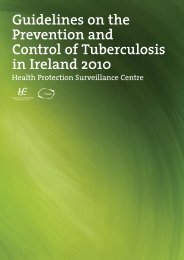Guidelines for the Early Clinical and Public Health Management of ...
Guidelines for the Early Clinical and Public Health Management of ...
Guidelines for the Early Clinical and Public Health Management of ...
You also want an ePaper? Increase the reach of your titles
YUMPU automatically turns print PDFs into web optimized ePapers that Google loves.
<strong>Guidelines</strong> <strong>for</strong> <strong>the</strong> <strong>Early</strong> <strong>Clinical</strong> <strong>and</strong> <strong>Public</strong> <strong>Health</strong> <strong>Management</strong> <strong>of</strong> Bacterial Meningitis (including Meningococcal Disease)<br />
Additional tests that may be useful include:<br />
• Direct microscopy <strong>and</strong> demonstration <strong>of</strong> intracellular Gram negative diplococci (GNDC) in scrapings from a<br />
petechial or purpuric lesion.<br />
• Culture <strong>for</strong> N. meningitidis from non-sterile site (throat, eye) is recommended as an adjunct to o<strong>the</strong>r samples<br />
as it may yield an isolate <strong>for</strong> epidemiological typing, however, this is not a diagnostic test.<br />
• Serological tests <strong>for</strong> antibody to N. meningitidis have been utilised in <strong>the</strong> past but are now rarely used.<br />
• In <strong>the</strong> case <strong>of</strong> isolates <strong>of</strong> N. meningitidis <strong>and</strong> H. influenzae, strain differentiation (phenotyping, molecular<br />
typing, <strong>and</strong> gene sequencing) is per<strong>for</strong>med at <strong>the</strong> Irish Meningococcal <strong>and</strong> Meningitis Reference Laboratory<br />
(IMMRL). In addition, epidemiological typing <strong>and</strong> antimicrobial susceptibility testing <strong>of</strong> invasive isolates <strong>of</strong><br />
group B streptococcus is available at <strong>the</strong> IMMRL.<br />
Epidemiological typing <strong>and</strong> detailed antimicrobial susceptibility testing <strong>of</strong> pneumococcal isolates is per<strong>for</strong>med by<br />
<strong>the</strong> Pneumococcal Pilot Typing Project (collaborative project between <strong>the</strong> RCSI Education <strong>and</strong> Research Centre,<br />
Department <strong>of</strong> <strong>Clinical</strong> Microbiology in Beaumont Hospital <strong>and</strong> CUH Temple St, <strong>and</strong> HPSC).<br />
Notification <strong>of</strong> any case <strong>of</strong> invasive disease causing meningitis should have regard to agreed case definitions under<br />
<strong>the</strong> infectious disease regulations.<br />
Isolation <strong>of</strong> <strong>the</strong> organism or a positive PCR test are <strong>the</strong> most commonly reported laboratory tests used to confirm<br />
disease.<br />
<strong>Public</strong> <strong>Health</strong> <strong>Management</strong> <strong>of</strong> Sporadic Cases <strong>of</strong> Invasive Meningococcal Disease<br />
• Nasopharyngeal carriage <strong>of</strong> N. meningitidis is common; with some 10% <strong>of</strong> <strong>the</strong> population carrying<br />
meningococci at any given time.<br />
• There is a well established increased risk <strong>of</strong> fur<strong>the</strong>r cases among <strong>the</strong> household contacts, <strong>and</strong> intimate<br />
kissing <strong>and</strong> sexual contacts <strong>of</strong> a case <strong>of</strong> meningococcal disease.<br />
• Settings where <strong>the</strong> increased risk is lower than that <strong>of</strong> household contacts include those in very close<br />
contact with a case after <strong>the</strong> onset <strong>of</strong> symptoms, <strong>and</strong> in childcare facilities.<br />
• When sporadic cases occur in schools <strong>and</strong> third level institutions, specific risk assessment is required to<br />
determine which contacts, if any, are at increased risk.<br />
• The public health response to meningococcal disease includes: identification <strong>of</strong> close contacts, arranging<br />
appropriate chemoprophylaxis <strong>and</strong> provision <strong>of</strong> appropriate in<strong>for</strong>mation.<br />
• The main reason <strong>for</strong> giving chemoprophylaxis is to eliminate meningococci from any carrier who may be<br />
in <strong>the</strong> network <strong>of</strong> contacts <strong>of</strong> each index case. This reduces <strong>the</strong> risk to o<strong>the</strong>r susceptible individuals in <strong>the</strong><br />
network, protecting <strong>the</strong>m from acquiring <strong>the</strong> meningococcal strain from <strong>the</strong> carrier <strong>and</strong> possibly developing<br />
invasive disease.<br />
• Depending on <strong>the</strong> serogroup <strong>of</strong> <strong>the</strong> index case, vaccination with MenC or MenACWY vaccine may be<br />
recommended <strong>for</strong> close contacts.<br />
• Throat swabs have no role in <strong>the</strong> public health management <strong>of</strong> contacts <strong>of</strong> invasive meningococcal disease.<br />
<strong>Public</strong> <strong>Health</strong> <strong>Management</strong> <strong>of</strong> Cases <strong>of</strong> Invasive Haemophilus Influenzae Type b (Hib) or Pneumococcal disease<br />
• Chemoprophylaxis is recommended <strong>for</strong> contacts <strong>of</strong> a case <strong>of</strong> invasive Hib disease only when <strong>the</strong>re is ano<strong>the</strong>r<br />
at risk individual in <strong>the</strong> contact network (see relevant section).<br />
• Chemoprophylaxis is not normally recommended <strong>for</strong> contacts <strong>of</strong> cases <strong>of</strong> sporadic pneumococcal meningitis<br />
(unless clusters <strong>of</strong> disease) (see relevant section).<br />
<strong>Management</strong> <strong>of</strong> clusters <strong>of</strong> invasive meningococcal disease<br />
• The objective <strong>of</strong> public health management <strong>of</strong> outbreaks is to interrupt <strong>the</strong> transmission <strong>of</strong> disease <strong>and</strong><br />
prevent fur<strong>the</strong>r cases occurring.<br />
• Clusters/outbreaks may be based in an institution or organisation or community.<br />
-13-

















